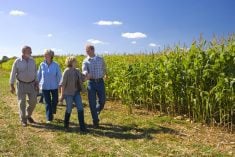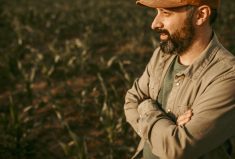When we talk about Canada’s aging farm owners, we generally talk about how best to pass the agricultural torch to sons and daughters or, more recently, about creative contortions to move the farm into the future with those who are not family — in short, succession planning. But is it still called succession when there is no successor, family or otherwise? And with no one waiting in the wings, how do we plan and execute the most successful and lucrative way out of a corporate farm?
Darren and Carmen Sterling at Weyburn, Sask., hadn’t thought much about their retirement. In fact, they hadn’t once looked at the goals they had committed to paper 20 years ago, back when they were in the process of creating a joint venture with Darren’s brother’s company as a means of taking over from their parents. At that time Darren wrote down his hope to retire from farming at age 55 while Carmen set her separate goals, and then the pages were promptly boxed up and put on a shelf.
Read Also

Riding the tariff rollercoaster
Farmers are accustomed to roller-coaster years. But the current geopolitical windstorm is something else entirely. On his cattle operation near…
When Darren’s brother retired, the Sterlings rented his land for a number of years before rolling his company into their own in 2018. At harvest of 2019, Shady Lane Farms Inc. was taking off about 8,000 acres of canola, wheat, lentils, soybeans and corn, with 3,200 of that owned, the rest rented. The farm had two long-term full-time employees and the Sterling’s daughters, Brooke and Shastidy, helped out when at home in the summer but were otherwise pursuing careers in health care.
The decision
If hindsight were 20/20, the Sterlings might have done things a little differently. “We really had no idea that two years later we’d be selling,” Carmen says. But when they sat down to review their operations, they both started thinking beyond the theoretical to the reality of their potential retirement. Carmen admits it took a while for them to speak openly about it, each afraid of unduly influencing the other’s decision.
“Are you ready to do this another seven to 10 years?” Carmen asked Darren as a means of opening the discussion. Their equipment was largely paid for and still had good value, but needed upgrades if the Sterlings were to keep farming. “Because if we purchase now that’s how long it will take to get back to our current position.”
These are difficult conversations for anyone. “The number one most difficult thing to decide is when is the last harvest,” says Dean Klippenstine. “It’s finding the balance between doing a good job of farming, operating at peak production, and deciding the point at which it’s time to start the next chapter.” A long-time partner and business advisor with the MNP Ag Team in Regina, Klippenstine says this kind of self-assessment can be emotional because in some cases partners can differ in their readiness.
It’s also about the kids. At Shady Lane Farms, the Sterlings consulted with their daughters who love the farm but want their careers. Darren had been farming since his teens. Looking at the options, he made his call. “I’m ready,” he told Carmen. They made their decision in the fall of 2019 and sold in spring 2020.
“We called the accountant and it was a shock to him,” Carmen says. “But I think the only way Darren could follow through and retire was to make the decision and have it happen quickly.”

There’s a point to be made that despite what can feel like haranguing from advisors to plan, plan, plan — we have to acknowledge that personalities and circumstances are going to play a role. With her long career in agriculture and business lending with RBC, Carmen knew many if not all the implications of the decision they were making, and agreed with her husband because it mattered to both of them.
“It’s been a win for me that Darren never wavered,” she says. “From the time we made the decision he was good with it.”
This doesn’t mean Darren is unaware they might have benefited from more planning, especially with regard to rolling Darren’s brother’s corporation shares into their own only two years prior. “We might have used the tax tools more effectively,” Carmen says. “We could have started five years before, even if we weren’t anticipating retirement, moving toward something that is inevitable for everyone.”
Business timelines
After the emotional decision about the last harvest (or milking, or cow sale), Dean Klippenstine says, “the number one business debate, especially with increasing land prices as we’ve seen in the Prairie provinces, is whether to liquidate operating assets and land, or to rent the land out and hold it as an investment. There’s no right or wrong way — it’s a personal decision — but each does have tax and other consequences.”
At Shady Lane Farms, the Sterlings chose the second option. Wanting to keep a land base should one of their daughters return to farm, and with neighbours ready to rent the land, the Sterlings sold everything else out of the corporation so that what remains is basically a land-holding investment company.
But things get a little more complicated if you want to sell it all. Specific to corporate farm sales, there are a few things to consider.
Lise Deleurme is owner at Lise Deleurme Chartered Professional Accountants in Notre-Dame-de-Lourdes, southwest of Winnipeg. She recommends making a plan and beginning its execution as much as five years ahead of the final sale, particularly where a producer has everything in the corporation.
To begin, Deleurme suggests grouping assets held in the corporation and spinning them off into separate entities in order to expand the base of potential buyers and ensure maximum value. Trying to sell any farm in its entirety could limit buyers who might want only one part or do not have the required equity base to purchase the whole.
All of this has to begin early so the new structure is in place at least three years prior to sale to avoid a CRA charge of tax avoidance.
Next Deleurme suggests examining the tax consequences of the sale of each asset group.
For our purposes let’s look at land only as the tax implications of its sale can be complicated and nuanced depending on how the sale is executed. Of course, the biggest of these considerations is the $1 million lifetime capital gains exemption available to every individual.
Tax tools
Unlike the sale of privately held farm land, the sale of corporate land holdings does not qualify for the capital gains exemption, meaning its liquidation will occasion a punitive tax if sold outside the corporation. Only the shares in a farm corporation qualify (See ‘Tax tools and definitions‘ further down).
“More and more the shares of the corporation are being sold with the land inside of it,” says MNP’s Dean Klippenstine. “It is an experience unique to agriculture.”
Example: Six quarters are owned in the corporation. An interested buyer meets the rules and criteria for a qualified farm company. The purchaser buys all the land in the corporation through the purchase of shares, and the seller uses any capital gain deduction he or she has remaining. The administrative burden put on the purchaser to amalgamate the two companies and for legal and accounting is minimal compared to the relative gain for the seller.
“You don’t have to sell from within the corporation, but most farms are not buying land at an after-tax corporate rate. Ninety-five per cent are now buying with corporate dollars,” Klippenstine says. “I would even be so bold as to say that if you are negotiating to sell land through corporation (shares) and they say no, you should find someone who will.”
In jurisdictions where competition for land is less intense, a slight discount might entice purchasers to go through, and pay for, this process. If a non-corporate entity wants to buy the land, it is basically the same process except the purchaser will have to set up a corporation to roll the purchased shares into.
Okay, so you might be exhausted by now. Carmen Sterling admits that having their land in the corporation created the biggest dilemma for them. “If we had understood the ramifications at the end of our farming career, we still would have incorporated but perhaps would have held the land personally… the financial management to do all of this and administer the land company has actually been harder than through our entire farming career.”
The accounting
Believe her. Remember that they had inventory creating an income stream well past the sale, plus there were deadlines around programs like AgriInvest, and they also had to monitor a variety of land ownership dates in relation to their sale and what that means to eligibility as a “qualified farmer”. Whew, shall we just say the whole thing is complex?

Dean Klippenstine admits it’s complicated even for the best accountants. “Our industry doesn’t have as good an understanding as we should simply because we never had a significant multi-generational transfer of (farm) wealth before, especially in the Prairie provinces. The last generation had a $1 million farm; now they are often worth several million.”
“Clients tell me they just want it to be simple again,” he says. “I tell them the only way to have it simple again is to be poor.”
“I want to emphasize one thing,” he adds more seriously. “Don’t assume the second you quit farming, you’ll wind up the farm corporation. You may cease operating a day-to-day farm, but most corporations continue to exist into the next generation as children use them as income and inheritance tools and use their capital gains exemption through them… It won’t be wound up, but you will live off the income generated by the assets.”
The alternative isn’t pretty. Let’s say you have a $3 million corporation, he says. If you sell the land and claim it as personal income, you maybe pay $1 to $1.2 million in taxes. If you leave the land in the corporation you will pay tax only on the annual income it generates. “Most of my clients would choose the latter.”
Both accountants believe most farmers underestimate their wealth.
Older farmers have built up a lot of equity so they need to plan how to get the most out of their sale while at the same time working on a financial retirement plan, says Lise Deleurme. She puts it this way: Are you ready?
“Are you ready if someone comes to your door with a good offer? Can you accept it without a huge tax hit? Are you ready to back away completely? What will the plan leave in your pocket, and will that make you financially ready for retirement depending on your age, how long you might live, and what you want to do in the future.”
Klippenstine agrees farmers don’t know their wealth and are consequently shocked at the post-sale tax hit. “Nobody seems to have a good handle on their taxable income,” he says. “On a grain farm you have your entire crop inventory and deferred income with no input costs, rent coming in, proceeds from the equipment auction; it’s a tidal wave of taxable income. And that’s just current taxable income, let alone the rest. So you have to think of the next generation and what will happen, look at the intergenerational, farm specific rules. You’ll need help with all of this because the consequences are huge to yourself and the future generation.”
Back at Shady Lane Farms, Carmen and Darren Sterling were ready. Their process was quicker than most, but they knew what they were getting into both emotionally and financially. They had to come to terms with letting go two long-time employees who were also friends. They are still waiting for the tax bill but are prepared for that too. And they have their head around upcoming deadlines related to landholdings and meeting criteria for qualified farming.
A few months after their auction, the Sterlings dug out the box they’d tucked away 20 years earlier and looked at the goals they’d forgotten they’d ever written. Darren had just turned 55.
Tax tools and definitions
Qualified farm property
- A share of the capital stock of, or interest in, a family farm that you or your spouse or common-law partner own.
- Real property, such as land and buildings.
- Property such as milk and egg quotas.
This seems fairly straightforward but BDO Canada warns it’s easy to run afoul of these definitions. “All or substantially all” of the value of assets in a corporation must be principally used in a farming business that a family member was actively engaged in. So be careful not to build up non-farming assets in the corp that won’t qualify for capital gains.
MNP’s Dean Klippenstine also cautions producers to be aware of the date land came into the corporation if they plan to maintain the land in an income-generating land company as the Sterling family did. The rules say your land has to be farmed more years than it’s rented out in order to “qualify,” so the purchase of land within two to five years of retiring might put you offside of the rules.
At Shady Lane Farms, Carmen Sterling says this has required them to monitor both the dates and how the land came into the farm as there are different rules regarding intergenerational, sibling or non-family acquisitions.
Intergenerational (tax free) rollover
- The transfer of qualifying farm interest to next-generation family members on a tax-deferred basis during their lifetime.
Prior to the transfer, the property must have been used principally (more than 50 per cent) in a farming business in which you, your spouse or any of your children were actively engaged on a regular and continuous basis in order to qualify for the rollover provisions. This “use” stipulation applies separately to each parcel of land.
Klippenstine says agriculture is “the only industry that has this option whether it is a passive asset or not.”
But be careful: the next generation must own the transferred property for at least three years in order to ensure the taxable gain doesn’t attribute back to the parent under charges of tax avoidance.
Alternative minimum tax
- The alternative minimum tax is a separate tax calculation determined in parallel with an individual’s regular income tax calculations. It is designed to ensure high income-earners pay a minimum despite deductions/programs available to them.
In the case of a farm sale this is triggered in the year in which the capital gain is triggered and is refundable over time.
“Older farmers have built up a lot of equity,” says Lise Deleurme from Lise Deleurme Accounting in Manitoba. “Sometimes their biggest mistake is waiting too long to sell the land. If you’re 80 or 90 you don’t have time to recoup the AMT you’ll pay and suddenly find yourself figuring out how to gift or distribute money to the grandkids because you’ve skipped a generation of succession and tax planning.”
Closing accounts
When it’s all said and done, be sure to make a checklist of federal and provincial deadlines and requirements for dissolution of a company, filing of final tax returns, and closing of all accounts such as payroll and GST/HST.
And another thing
Old Age Security, and programs such as the seniors drug plan and home care costs are all calculated based on income. While they might seem like small amounts compared to the income from a sale, they add up over the years so be aware and work with your advisor to manage these programs within your financial plan.















